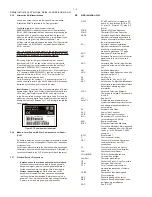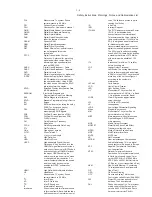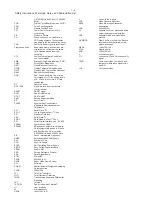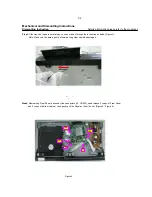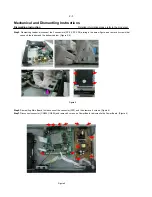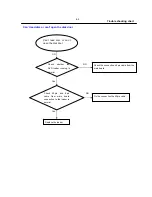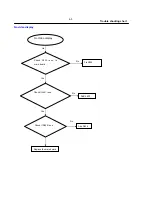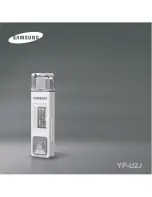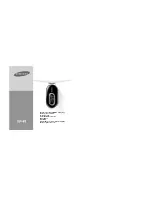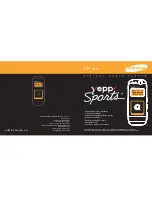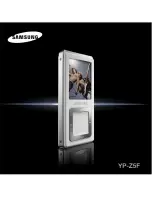
Safety Instructions, Warnings, Notes, and Abbreviation List
2.3.5
Alternative BOM identification
It should be noted that on the European Service website,
“Alternative BOM” is referred to as “Design variant”.
The
third digit
in the serial number (example:
KX
2
B0835000001) indicates the number of the alternative
B.O.M. (Bill Of Materials) that has been used for producing the
specific AV set. In general, it is possible that the same AV
model on the market is produced with e.g. two different types
of display, coming from two different suppliers. This
will then result in sets which have the same CTN (Commercial
Type Number; e.g. MCM394/12) but which have a different
B.O.M. number.
Also, it is possible that same model on the market is produced
with two production centers, however their partslist is the same.
In such case, no alternative B.O.M. will be created.
By looking at the third digit of the serial number, one can
identify which B.O.M. is used for the set he is working with.
If the third digit of the serial number contains the number “1”
(example: KX
1
B033500001), then the set has been
manufactured according to B.O.M. number 1. If the third digit is
a “2” (example: KX
2
B0335000001), then the set has been
produced according to B.O.M. no. 2. This is important for
ordering the correct spare parts!
For the third digit, the numbers 1...9 and the characters A...Z
can be used, so in total: 9 plus 26= 35 different B.O.M.s can be
indicated by the third digit of the serial number.
Identification:
The bottom line of a type plate gives a 14-digit
serial number. Digits 1 and 2 refer to the production centre (e.g.
LM is Arts), digit 3 refers to the B.O.M. code, digit 4 refers
to the Service version change code, digits 5 and 6 refer to the
production year, and digits 7 and 8 refer to production week (in
example below it is 2008 week 50). The 6 last digits contain the
serial number.
Figure 2-1 Serial number (example)
2.3.6
Module Level Repair (MLR) or Component Level Repair
(CLR)
If a board is defective, consult your repair procedure to decide
if the board has to be exchanged or if it should be repaired on
component level.
If your repair procedure says the board should be exchanged
completely, do not solder on the defective board. Otherwise, it
cannot be returned to the O.E.M. supplier for back charging!
2.3.7
Practical Service Precautions
•
It makes sense to avoid exposure to electrical shock.
While some sources are expected to have a possible
dangerous impact, others of quite high potential are of
limited current and are sometimes held in less regard.
•
Always respect voltages
. While some may not be
dangerous in themselves, they can cause unexpected
reactions that are best avoided. Before reaching into a
powered TV set, it is best to test the high voltage insulation.
It is easy to do, and is a good service precaution.
2.4
Abbreviation List
0/6/12
SCART switch control signal on A/V
board. 0 = loop through (AUX to TV),
6 = play 16 : 9 format, 12 = play 4 : 3
format
2DNR
Spatial (2D) Noise Reduction
3DNR
Temporal (3D) Noise Reduction
AARA
Automatic Aspect Ratio Adaptation:
algorithm that adapts aspect ratio to
remove horizontal black bars; keeps
the original aspect ratio
ACI
Automatic Channel Installation:
algorithm that installs TV channels
directly from a cable network by
means of a predefined TXT page
ADC
Analogue to Digital Converter
AFC
Automatic Frequency Control: control
signal used to tune to the correct
frequency
AGC
Automatic Gain Control: algorithm that
controls the video input of the feature
box
AM
Amplitude Modulation
ANR
Automatic Noise Reduction: one of the
algorithms of Auto TV
AP
Asia Pacific
AR
Aspect Ratio: 4 by 3 or 16 by 9
ASF
Auto Screen Fit: algorithm that adapts
aspect ratio to remove horizontal black
bars without discarding video
information
ATSC
Advanced Television Systems
Committee, the digital TV standard in
the USA
ATV
See Auto TV
Auto TV
A hardware and software control
system that measures picture content,
and adapts image parameters in a
dynamic way
AV
External Audio Video
AVC
Audio Video Controller
AVIP
Audio Video Input Processor
B/G
Monochrome TV system. Sound
carrier distance is 5.5 MHz
BLR
Board-Level Repair
BTSC
Broadcast Television Standard
Committee. Multiplex FM stereo sound
system, originating from the USA and
used e.g. in LATAM and AP-NTSC
countries
B-TXT
Blue TeleteXT
C
Centre channel (audio)
CEC
Consumer Electronics Control bus:
remote control bus on HDMI
connections
CL
Constant Level: audio output to
connect with an external amplifier
CLR
Component Level Repair
COLUMBUS
COlor LUMinance Baseband
Universal Sub-system
ComPair
Computer aided rePair
CP
Connected Planet / Copy Protection
CSM
Customer Service Mode
CTI
Color Transient Improvement:
manipulates steepness of chroma
transients
CVBS
Composite Video Blanking and
Synchronization
DAC
Digital to Analogue Converter
DBE
Dynamic Bass Enhancement: extra
low frequency amplification
DDC
See “E-DDC”
Model FWM572/12
220-230 50Hz 60W
FWM572/12
LM1A0850005644
1 - 4




